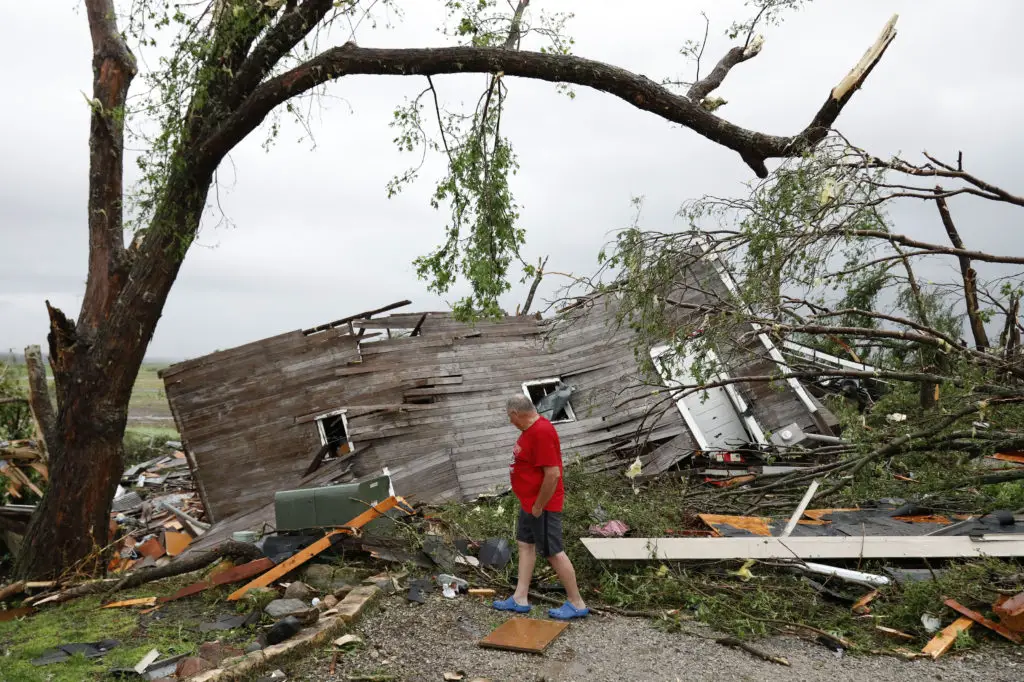KANSAS CITY, Mo. — A vicious storm tore through the Kansas City area, spawning tornadoes that downed trees and power lines, damaged homes and injured at least a dozen people in the latest barrage of severe weather that saw tornado warnings as far east as New York City.
The latest round of damaging weather in the central U.S. came a day after violent storms killed one person and injured at least 130 in Indiana and Ohio.
Mark Duffin, 48, learned from his wife and a television report that the large tornado was headed toward his home in Linwood, Kansas, about 30 miles (48 kilometers) west of Kansas City.
The next thing he knew, the walls of his house were coming down.
Duffin told the Kansas City Star that he grabbed a mattress, followed his 13-year-old to the basement and protected the two of them with the mattress as the home crashed down around them.
“I’m just glad I found my two dogs alive,” he said. “Wife’s alive, family’s alive, I’m alive. So, that’s it.”
At least a dozen people were admitted to the hospital in Lawrence, Kansas, which is about 40 miles (64 kilometers) west of Kansas City, Missouri, and is home to the University of Kansas, hospital spokesman Janice Early said. Damage also was reported in the towns of Bonner Springs and Pleasant Grove.
The Douglas County (Kansas) Emergency Management agency said on Facebook that 15 people were hurt, including three seriously, during the storms, which spawned a twister that struck a neighborhood just outside of Lawrence.
The Kansas City metropolitan area of about 2.1 million people appeared to have been spared the direct hit that was feared earlier in the evening, when the weather service announced a tornado emergency.
Still, the storm forced evacuations at Kansas City International Airport. People took refuge in a tunnel leading to the parking garage for about an hour. Flights were delayed for more than five hours due to debris on the airfield. Airport spokesman Joe McBride said the debris included pots, wall panels and other items that apparently flew in the air nearly 50 miles (80 kilometers) from the Linwood tornado.
Flights finally resumed around 12:15 a.m.
Tuesday marked the 12th straight day that at least eight tornadoes were reported to the National Weather Service. The last such stretch was in 1980. The weather service website showed at least 27 reports of tornadoes on Tuesday, most in Kansas and Missouri but also in Pennsylvania and Illinois.
After several quiet years, the past couple of weeks have seen an explosion of tornado activity with no end to the pattern in sight.
Tornadoes also were confirmed in eastern Pennsylvania and the weather service issued a tornado warning for parts of New York City and northern New Jersey.
The winds peeled away roofs leaving homes looking like giant dollhouses knocked houses off their foundations, toppled trees, brought down power lines and churned up so much debris that it was visible on radar. Highway crews had to use snowplows to clear an Ohio interstate.
Some of the heaviest damage was reported just outside Dayton, Ohio.
“I just got down on all fours and covered my head with my hands,” said Francis Dutmers, who with his wife headed for the basement of their home in Vandalia, about 10 miles (16 kilometers) outside Dayton, when the storm hit with a “very loud roar” Monday night. The winds blew out windows around his house, filled rooms with debris and took down most of his trees.
Ohio Gov. Mike DeWine declared a state of emergency in three hard-hit counties, allowing the state to suspend normal purchasing procedures and quickly provide supplies like generators and water.
Tornadic winds weren’t the only problem. Several water rescues were reported in northern Missouri. In sparsely populated Putnam County, officials urged everyone to stay off roads because flooding was rampant after the county got 2 inches (5.1 centimeters) of rain in 20 minutes Tuesday night.
Hannibal, Missouri, officials were just beginning to assess damage Wednesday, hours after torrential rain proved too much for the storm sewers, causing a break that resulted in water damage to buildings in the historic downtown area.
Weather service meteorologist Mark Fuchs said parts of Holt County, Missouri, got 6 inches (15.2 centimeters) of rain, and a widespread area along the Iowa-Missouri border got at least 3 inches (7.6 centimeters). He said most of that water will drain into the swollen Missouri River and that some will join the Mississippi River, which is already approaching record highs in several Missouri and Illinois communities.
Outbreaks of 50 or more tornadoes are not uncommon, having happened 63 times in U.S. history, with three instances of more than 100 twisters, said Patrick Marsh, warning coordination meteorologist for the federal Storm Prediction Center. But Monday’s swarm was unusual because it happened over a particularly wide geographic area and came amid an especially active stretch, he said.
As for why it’s happening, Marsh said high pressure over the Southeast and an unusually cold trough over the Rockies are forcing warm, moist air into the central U.S., triggering repeated severe thunderstorms and tornadoes. And neither system is showing signs of moving, he said.
Scientists say climate change is responsible for more intense and more frequent extreme weather such as storms, droughts, floods and fires, but without extensive study they cannot directly link a single weather event to the changing climate.


